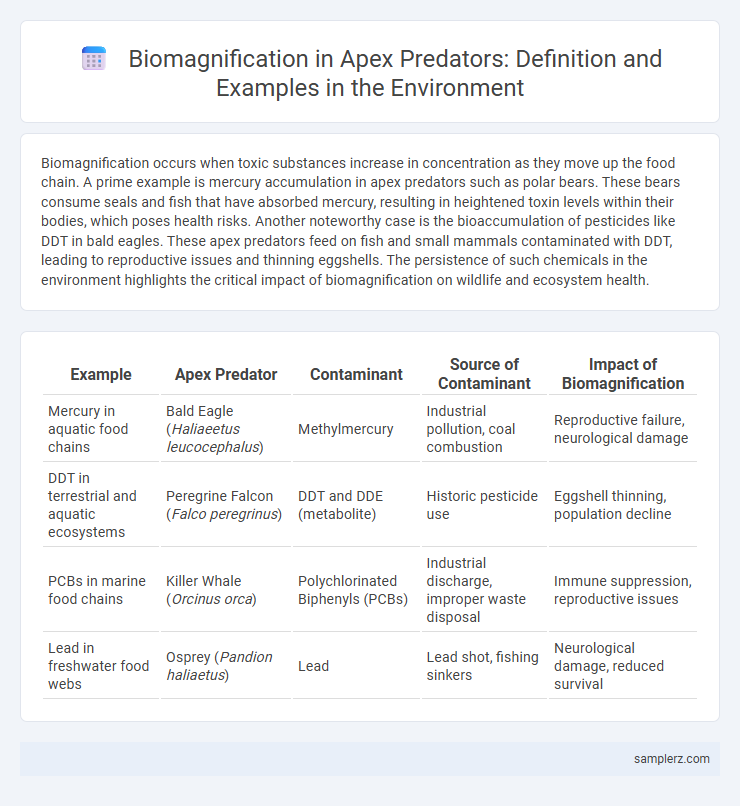Biomagnification occurs when toxic substances increase in concentration as they move up the food chain. A prime example is mercury accumulation in apex predators such as polar bears. These bears consume seals and fish that have absorbed mercury, resulting in heightened toxin levels within their bodies, which poses health risks. Another noteworthy case is the bioaccumulation of pesticides like DDT in bald eagles. These apex predators feed on fish and small mammals contaminated with DDT, leading to reproductive issues and thinning eggshells. The persistence of such chemicals in the environment highlights the critical impact of biomagnification on wildlife and ecosystem health.
Table of Comparison
| Example | Apex Predator | Contaminant | Source of Contaminant | Impact of Biomagnification |
|---|---|---|---|---|
| Mercury in aquatic food chains | Bald Eagle (Haliaeetus leucocephalus) | Methylmercury | Industrial pollution, coal combustion | Reproductive failure, neurological damage |
| DDT in terrestrial and aquatic ecosystems | Peregrine Falcon (Falco peregrinus) | DDT and DDE (metabolite) | Historic pesticide use | Eggshell thinning, population decline |
| PCBs in marine food chains | Killer Whale (Orcinus orca) | Polychlorinated Biphenyls (PCBs) | Industrial discharge, improper waste disposal | Immune suppression, reproductive issues |
| Lead in freshwater food webs | Osprey (Pandion haliaetus) | Lead | Lead shot, fishing sinkers | Neurological damage, reduced survival |
Introduction to Biomagnification in Apex Predators
Apex predators, such as orcas and eagles, exemplify biomagnification through the accumulation of toxic substances like mercury and polychlorinated biphenyls (PCBs) in their tissues. These contaminants increase in concentration at each trophic level, reaching harmful levels in top predators. The heightened toxin load poses significant risks to their reproduction, immune function, and survival, highlighting the critical impact of biomagnification in aquatic and terrestrial ecosystems.
Definition and Process of Biomagnification
Biomagnification is the process by which toxic substances such as heavy metals or persistent organic pollutants increase in concentration as they move up the food chain. Apex predators, like polar bears and sharks, accumulate these harmful chemicals at higher levels because they consume prey that have progressively concentrated toxins in their tissues. This leads to significant health risks and ecosystem imbalances due to the amplified exposure to environmental contaminants.
Key Pollutants Involved in Biomagnification
Mercury and polychlorinated biphenyls (PCBs) are primary pollutants involved in biomagnification, accumulating in apex predators such as sharks and eagles. These toxic substances increase in concentration through the food chain, leading to severe physiological damage and reproductive issues in top predators. Monitoring these pollutants helps assess ecosystem health and implement targeted environmental protection strategies.
Apex Predators Most Affected by Biomagnification
Apex predators such as polar bears, eagles, and large fish like tuna are most affected by biomagnification due to their position at the top of the food chain, where toxic substances like mercury and PCBs accumulate at higher concentrations. These contaminants increase exponentially as they move up each trophic level, causing severe health issues including reproductive failures and immune system damage in these species. Monitoring biomagnification in apex predators is critical for assessing ecosystem health and the long-term impact of pollutants on biodiversity.
Case Study: Mercury Accumulation in Tuna
Mercury biomagnification in tuna showcases the accumulation of toxic methylmercury in apex predators through the marine food web. Tuna, as top-level consumers, ingest contaminated smaller fish, leading to mercury concentrations thousands of times higher than in surrounding water. This case study highlights the critical impact of industrial mercury emissions on marine ecosystems and human health through seafood consumption.
DDT Biomagnification in Birds of Prey
DDT biomagnification in birds of prey, such as eagles and falcons, leads to dangerously high concentrations of this pesticide in their bodies due to their position at the top of the food chain. This accumulation causes eggshell thinning, resulting in reduced reproductive success and population declines. Studies have shown that DDT magnifies up to a million-fold from water to apex predators, severely impacting avian ecosystems.
Effects of PCBs on Marine Mammals
Polychlorinated biphenyls (PCBs) accumulate in marine mammals like orcas and seals through biomagnification, reaching toxic concentrations in their fatty tissues. These contaminants disrupt endocrine functions, impair immune systems, and reduce reproductive success, leading to population declines. The persistent nature of PCBs in ocean ecosystems exacerbates long-term health risks for apex predators at the top of the food chain.
Ecological Impacts on Food Web Stability
Mercury accumulation in apex predators like orcas demonstrates biomagnification's severe ecological impacts by disrupting reproduction and behavior, ultimately destabilizing food web dynamics. These predators' declining populations alter prey abundance, leading to trophic cascades that compromise ecosystem resilience. Persistent pollutants magnify through trophic levels, emphasizing the critical need for monitoring and mitigating contaminant sources to preserve food web stability.
Human Health Risks Linked to Biomagnification
Mercury accumulation in apex predators such as tuna and swordfish exemplifies biomagnification, posing significant human health risks when these fish are consumed. Elevated mercury levels can lead to neurological damage, cognitive impairments, and developmental issues, particularly in pregnant women and young children. Monitoring and regulating mercury emissions is critical to minimizing these toxic threats within marine food webs and protecting public health.
Strategies to Reduce Biomagnification in Ecosystems
Apex predators like polar bears accumulate high levels of toxins such as mercury and PCBs through biomagnification, posing significant threats to their health and ecosystem stability. Implementing strategies such as reducing industrial emissions of persistent organic pollutants, enforcing stricter regulations on pesticide use, and restoring contaminated habitats helps minimize toxin entry and accumulation in food webs. Promoting ecological balance through conservation efforts and monitoring pollutant levels in apex predators supports the reduction of biomagnification impacts across ecosystems.

example of biomagnification in apex predator Infographic
 samplerz.com
samplerz.com